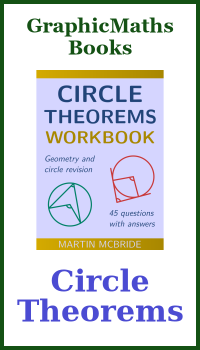Sum of square roots (Romanian Olympiad)
Categories: recreational maths olympiad

This problem is from a Romanian Olympiad.

Prove that the integer part of the following sum is 26:

You must do this without using approximations to the values of the square roots.
There are several ways to tackle this problem, one of which is presented below. You may want to try solving it yourself before reading the rest of the article.
Basic approach
The problem would be very easy if we were allowed to approximate the square roots. For example, if we used the Newton-Raphson method we could calculate each square root to 3 decimal places and add them up. If we got an answer that was definitely 26-point-something, that would be a solution ... but where is the fun in that?
But the problem states that we are not allowed to do that, so we must take a different approach. We will attempt to use logical arguments to prove that:
- The result is < 27.
- The result is ≥ 26.
Proving these two things will prove that the integer part of the result is 26.
Rearranging the terms
With these types of problems, it is often useful to consider why the problem has been set in the exact way it has. The parameters of the problem are often chosen to allow an elegant solution, and analysing the exact form of the problem can often give a clue as to what that solution might be.
In this case, notice that the only perfect square in the list is 9, and that appears right in the centre of the list. Perhaps there is a reason for this?
In these sorts of situations (an odd number of increasing values), one thing we might consider is to pair the values. We can start from opposite ends of the list, like this:

Each pair of roots contains two values that add to 18, which might lead to some kind of similarity between those values. That might allow us to make a general inference about the values. The odd value at the end is the root of 9, which of course is 3.
Proving the sum is less than 27
Let's take a look at one of the pairs of roots. We will choose the last one, and call the value A:
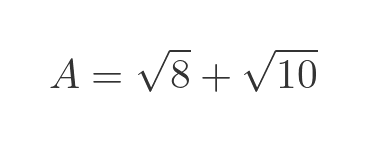
One possible way to simplify this might be to square the value, and then take the square root. Since we are dealing with positive quantities we ignore the possibility of a negative square root. This would reduce the number of roots in each expression. We can then gather the integer terms, and combine the square roots:
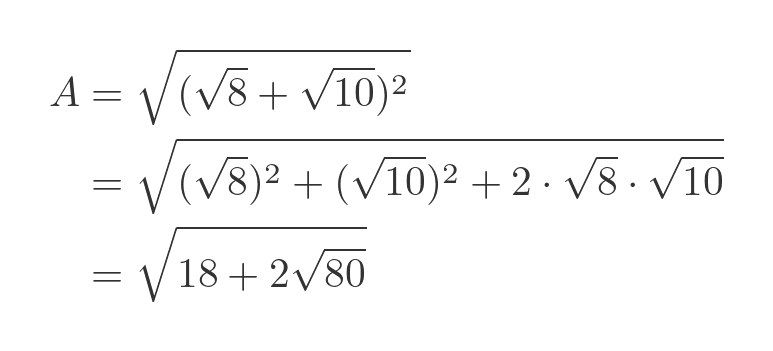
Now let's do the same thing for the second to last term, which we will call B:
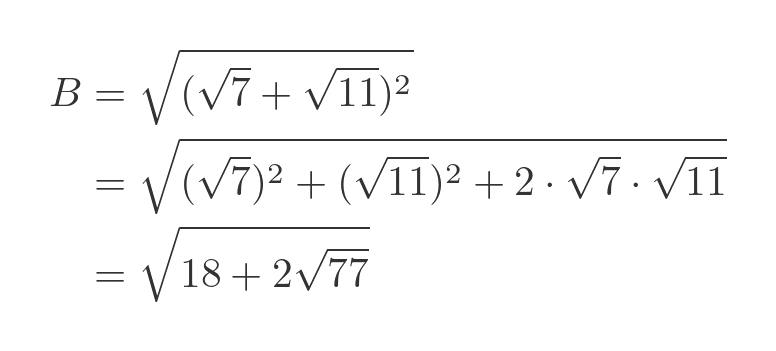
As we hoped, this term is quite similar. It takes exactly the same form but with a different value under the inner square root.
Now let's do the same for the other two terms:
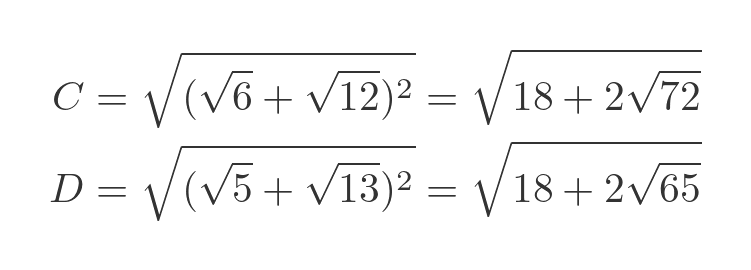
All four terms take a similar form, but in each case, the value under the inner square root is smaller. This means that the terms A to D get smaller:

We want to show that the sum of all the terms is < 27, and we can write this in terms of A to D as:

This condition would certainly be true if all the values A to D were < 6. That would mean that the sum would have to be < 27. But since we know that A is the largest value, all we need to prove is that A < 6, then the other values would also be < 6.
To do this, consider the value M:
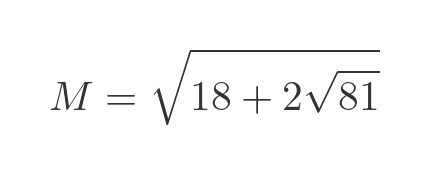
Since the value under the square root is 81 (compared to 80 for A), we can say that M > A. But since the square root of 81 is 9, we can find the exact value of M

So we have proved that M is equal to 6. Since values A to D are all less than M, then the sum of those values must be < 24. So the original sum of the square roots of 5 to 13 must be less than 27.
Proving the sum is greater than or equal to 26
We also need to prove that the sum of all the terms is ≥ 26. We can do this in a very similar way. We need to show that:

In other words:

We know that D is the smallest of the four values, so if D is ≥ 23/4 then the sum of A to D must be ≥ 23. So we need to prove that:
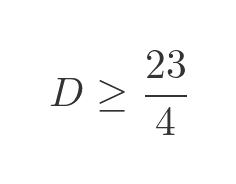
Recall that D is given by:

Let's find a value m that is smaller than D but has a nice square root. This is similar to the method we used with A and M. We will use an m value of:

Now if m is ≥ 23/4, D will be too, because D is bigger than m. We need to show that:
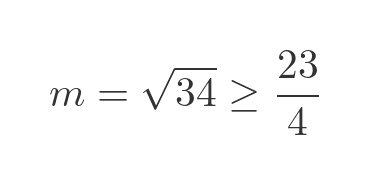
We can square both sides:
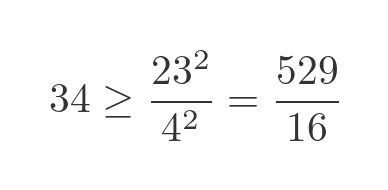
Multiplying through by 16 gives:

This condition is indeed true, proving that the sum of the terms must be ≥ 26.
Summary
We have analysed this problem by splitting it into the sum of four terms involving square roots plus the square root of 9, which of course is 3.
By proving that the largest of the four terms is less than 6, we can say that the sum of the terms must be less than 27 (because 4x6 + 3 is 27). By proving that the smallest term is greater than or equal to 23/4, we can say that the sum of the terms is greater than or equal to 26 (because 4x23/4 + 3 is 26). This proves the result.
Related articles
Join the GraphicMaths Newsletter
Sign up using this form to receive an email when new content is added to the graphpicmaths or pythoninformer websites:

Popular tags
adder adjacency matrix alu and gate angle answers area argand diagram binary maths cardioid cartesian equation chain rule chord circle cofactor combinations complex modulus complex numbers complex polygon complex power complex root cosh cosine cosine rule countable cpu cube decagon demorgans law derivative determinant diagonal directrix dodecagon e eigenvalue eigenvector ellipse equilateral triangle erf function euclid euler eulers formula eulers identity exercises exponent exponential exterior angle first principles flip-flop focus gabriels horn galileo gamma function gaussian distribution gradient graph hendecagon heptagon heron hexagon hilbert horizontal hyperbola hyperbolic function hyperbolic functions infinity integration integration by parts integration by substitution interior angle inverse function inverse hyperbolic function inverse matrix irrational irrational number irregular polygon isomorphic graph isosceles trapezium isosceles triangle kite koch curve l system lhopitals rule limit line integral locus logarithm maclaurin series major axis matrix matrix algebra mean minor axis n choose r nand gate net newton raphson method nonagon nor gate normal normal distribution not gate octagon or gate parabola parallelogram parametric equation pentagon perimeter permutation matrix permutations pi pi function polar coordinates polynomial power probability probability distribution product rule proof pythagoras proof quadrilateral questions quotient rule radians radius rectangle regular polygon rhombus root sech segment set set-reset flip-flop simpsons rule sine sine rule sinh slope sloping lines solving equations solving triangles square square root squeeze theorem standard curves standard deviation star polygon statistics straight line graphs surface of revolution symmetry tangent tanh transformation transformations translation trapezium triangle turtle graphics uncountable variance vertical volume volume of revolution xnor gate xor gate
